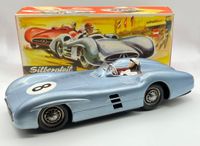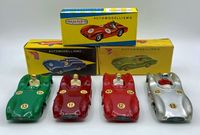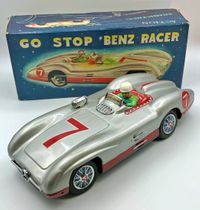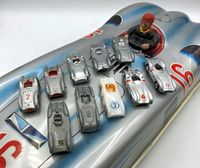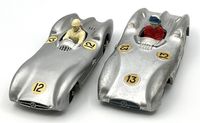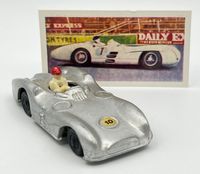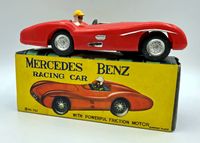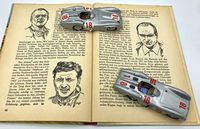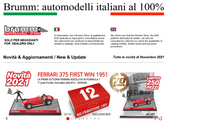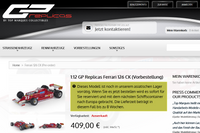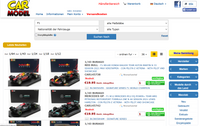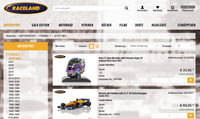Blogs 2023
Mercedes W196: The most popular Formula 1 model
Have you ever wondered which Formula 1 car has the most different models? After almost 45 years of collecting, the answer is easy: it is the streamlined version of the Mercedes W196 from 1954/55. No other model has so many different variants – in almost every possible size.
Why is it the Mercedes W196? For one thing, it has to do with the success of Mercedes. The German brand's comeback to racing was brilliant. Exactly 40 years after Christian Friedrich Lautenschlagers victory in the 1914 French Grand Prix, the German manufacturer won on his return. "It was the time after the war," remembers Hans Hermann (94), the last living driver from that time. "I was the youngest in the team next to the great Fangio and Karl Kling. The way we performed in Reims at that time was very dominant. We were vastly superior to the competition. And everything was so meticulously planned. That didn't only trigger good feelings in me as a German racing driver."
While Hermann retired with an engine failure and he had to console himself with the fastest race lap, Fangio and Kling drove a lonely race at the front. After 61 laps, only 0.1 seconds separated the two. The rest of the field was at least one lap behind. At the following Grand Prix in Silverstone, Mercedes was not competitive with the streamlined W196. Fangio was only fourth, a lap down. The full fairing proved to be a hindrance on the 4.8 kilometre circuit with eight corners and only short straights. On the track surrounded by straw bales and marked with sand-filled barrels, cars with precise steering and free-standing wheels had clearly an advantage.
For the next race at the Nürburgring, Mercedes reacted and used only one version of the streamliner (for Hermann). Fangio and Kling drove a lighter and more manoeuvrable version with free-standing wheels at the Nürburgring. And promptly Fangio won again. Also in Bern and Monza (again with the streamlined version) the competition had nothing to oppose the fast Argentinean, so that Fangio was already determined as the new world champion before the final race in Spain (with the monoposto version).
In 1955, the dominance of the Silver Arrows continued. Fangio won four races, his new team mate Stirling Moss won his home race in Great Britain. Only at the Monaco Grand Prix (and of course at the Indy 500) did Mercedes come away empty-handed. Fangio had a problem with the transmission in Monaco and retired while leading. Moss (also in the lead) suffered an engine failure. Frenchman André Simon stepped in for Hermann, who had a serious accident during practice. At the end of the year Fangio secured the title again – ahead of Moss. After that, Mercedes said goodbye to Formula 1 and only came back as an engine manufacturer in 1994 with the British engine manufacturer Ilmor as a partner. Since 2010, Mercedes has again its own team, with which it dominated the hybrid era from 2014-2020.
The question which toy manufacturer was the first to launch the streamlined version of the Silver Arrow cannot be fully resolved. At the time, they all produced the W196: Mercury, Dinky Toys, Crescent Toys, Märklin, Möbius, Lion. One thing is certain: Most manufacturers relied on the W196 from the 1954 Silverstone Grand Prix. That car had the Mercedes star in the radiator grille. This was not the case with the other models.
One of these first models, the 1957 Dinky Toys version, still puzzles me today. Why did Dinky Toys Britain released the Silver Arrow in white and not in silver? And if they took the model from the British Grand Prix, why did they take #30 and not #1 or #2, as Fangio and Kling used that day? The answer isn’t written anywhere. Fact is: Dinky Toys was not the only manufacturer experimenting with wrong colours at that time. The Danish toy manufacturer Lion Toys also had two variants in red and black in its range in addition to a silver W196 in streamlined form. And perhaps Dinky Toys simply wanted to remind us of the good old days. Because originally the Silver Arrows actually drove in white. At least until 2nd of June 1934. On the eve of the Eifel race, it turned out that the W25s used at the time for Manfred von Brauchitsch and Luigi Fagioli were one kilogram over the weight limit. Mercedes-Benz race director Alfred Neubauer ordered that the white paint should be removed in order to save weight.
In addition to diecast models, sheet metal was also very popular in the mid-fifties. One of the best-known manufacturers of tin toys was JNF. The Mercedes W196 was available from the toy company from Fürth in both versions (as a streamliner and with free-standing wheels) and in different colour variants in 1:18 scale. The Japanese manufacturer Marusan Toys also scaled down the W196 with a battery drive in 1:18 in at least two different variants (red and silver). Other well-known manufacturers of Mercedes W196 models in sheet metal were Joustra from France, Höfler from Germany and Lincoln from New Zealand, the latter – it seems – rebuilding the W196 according to Höfler's moulds. Somewhat smaller and, according to my research, available from about 1962 was the Mercedes W196 from CKO Kellermann. This approx. 12 cm tall sheet metal model also has a friction wheel drive.
Probably the greatest variety of W196 models was available in the sixties among the plastic models. Some of them turned out very well. For example the Silver Arrow by Minialuxe in approx. 1:32, which is massively off-colour in its striking yellow, but scores points with a nice cardboard box. I also appreciate the W196 from Tri-ang Minic in identical size. Not only is the packaging right, the British model is also well-coloured.
Probably the most beautiful plastic models come from Italy. Although I have no proof of this, I suspect that the model makers from Milan have taken a model from Crescent Toys as an example. If you hold the Crescent and Sam Toys models next to each other, the similarity is amazing. I would also have liked to show a picture of the Mercedes from Isat Toys, because this model also seems to me to be very lovely. Supposedly, the model of the company from Milano existed in 1:43rd scale. But I only know the smaller version in 1:66.
The plastic model of the W196 by Monsavon also has a special charm. The French soap manufacturer produced this model as a promotional gift in the sixties. A similar product was also available from a Belgian manufacturer called "Francorchamps". The search for W196 scale models in H0 is also exciting. Besides the more well-known manufacturers such as Eko (from Spain) and Wiking (from Germany), there are a number of other manufacturers such as Sam Toys (Italy), Joy Toy (Greece), Anguplast (Spain), APS and Lima (both Italy), Marx (USA) as well as KoHo and Manurba (both Germany). In modern times, too, many manufacturers have dared to tackle what is probably the most famous Silver Arrow. In 1:43rd scale, I'm thinking of Brumm, Minichamps, IXO or Spark. In 1/18th scale there is the W196 from CMC, Schuco, Franklin Mint or GP Replicas. In H0 scale there are models from Bub and Morem.
Haben Sie sich auch schon gefragt, von welchem Formel-1-Auto es die meisten Nachbauten gibt? Nach bald 45 Jahren Sammelleidenschaft fällt die Antwort leicht: Es ist die Stromlinienversion des Mercedes W196 von 1954/55. Von keinem anderen Modell existieren so viele verschiedene Varianten – in nahezu allen erdenklichen Größen.
Warum ausgerechnet der Mercedes W196? Zum einen hat das mit dem Erfolg von Mercedes zu tun. Das Comeback der deutschen Marke im Rennsport war fulminant. Exakt 40 Jahre nach dem Sieg von Christian Friedrich Lautenschlager 1914 beim Grand Prix von Frankreich siegten die Schwaben bei ihrer Rückkehr. «Es war die Zeit nach dem Krieg», erinnert sich Hans Hermann (94), der letzte noch lebende Fahrer von damals. «Ich war der Jüngste im Team neben dem großen Fangio und Karl Kling. Die Art, wie wir damals in Reims aufgetreten sind, war sehr dominant. Wir waren der Konkurrenz haushoch überlegen. Und alles war so generalstabsmäßig geplant. Das löste in mir als deutscher Rennfahrer nicht nur gute Gefühle aus.»
Während Hermann beim Comeback der Silberpfeile mit einem Motorschaden ausfiel und sich mit der schnellsten Rennrunde trösten musste, fuhren Fangio und Kling an der Spitze ein einsames Rennen. Nach 61 Runden trennten die beiden nur 0,1 Sekunden. Der Rest des Feldes lag mindestens eine Runde zurück. Beim darauffolgenden Grand Prix in Silverstone stand Mercedes mit dem Stromlinien-W196 auf verlorenem Posten. Fangio wurde mit Rundenrückstand nur Vierter. Die Vollverkleidung erwies sich auf dem 4,8 Kilometer langen Kurs mit acht Kurven und nur kurzen Geraden als hinderlich. Auf der von Strohballen umgebenen und mit Sand gefüllten Fässern markierten Strecke waren präzise zu steuernde Fahrzeuge mit freistehenden Rädern von Vorteil.
Für das nächste Rennen am Nürburgring reagierte Mercedes und setzte nur eine Version des Stromlinienfahrzeugs ein (für Hermann). Fangio und Kling nahmen in einer leichteren und für den Nürburgring wendigeren Version mit freistehenden Rädern Platz. Und prompt siegte Fangio wieder. Auch in Bern und Monza (wieder mit der Stromlinienversion) hatte die Konkurrenz dem schnellen Argentinier nichts entgegenzusetzen, sodass Fangio bereits vor dem Finale in Spanien (mit der Monoposto-Version) als neuer Weltmeister feststand.
1955 ging die Dominanz der Silberpfeile weiter. Fangio gewann vier Rennen, sein neuer Teamkollege Stirling Moss triumphierte bei dessen Heimspiel in Großbritannien. Nur beim Grand Prix von Monaco (und natürlich beim Indy 500) ging Mercedes leer aus. Fangio hatte im Fürstentum ein Problem mit der Kraftübertragung und schied in Führung liegend aus. Moss (ebenfalls in Führung liegend) beklagte ein Motorschaden. Für Hermann, der im Training schwer verunfallte, sprang der Franzose André Simon ein. Am Ende des Jahres sicherte sich Fangio erneut den Titel – vor Moss. Danach verabschiedete sich Mercedes aus der Formel 1 und kam erst 1994 als Motorenhersteller mit der britischen Motorenschmiede Ilmor als Partner zurück. Seit 2010 setzt Mercedes wieder ein eigenes Team ein, mit dem man die Hybrid-Ära von 2014-2020 dominierte.
Die Frage, welcher Spielzeug-Hersteller den Silberpfeil in Stromlinienversion als Erstes auf den Markt brachte, kann nicht vollständig geklärt werden. Alle hatten sie damals den W196 am Start: Mercury, Dinky Toys, Crescent Toys, Märklin, Möbius, Lion. Fest steht: Die meisten Hersteller nahmen den W196 vom Grand Prix in Silverstone 1954 als Vorlage. Dieser hatte nämlich den Mercedes-Stern im Kühlergrill. Was bei den anderen Modellen nicht der Fall war.
Eines dieser ersten Modelle, die 1957 erschienene Dinky-Toys-Variante, gibt mir bis heute Rätsel auf. Warum haben die Engländer den Silberpfeil in Weiß und nicht in Silber herausgebracht? Und wenn man schon das Modell vom Grand Prix von Großbritannien als Vorbild nahm, warum hat man dann die #30 und nicht die #1 oder #2 genommen, so wie sie an diesem Tag Fangio und Kling fuhren? Die Antwort steht nirgendwo geschrieben. Fakt ist: Dinky Toys war nicht der einzige Hersteller, der zu dieser Zeit mit falschen Farben experimentierte. Auch der dänische Spielzeugfabrikant Lion Toys hatte neben einem silbernen W196 in Stromlinienform noch zwei Varianten in Rot und Schwarz im Sortiment. Und vielleicht wollte Dinky Toys auch einfach an die gute alte Zeit erinnern. Denn ursprünglich fuhren die «Silberpfeile» tatsächlich in Weiß. Zumindest bis zum 2. Juni 1934. Am Vorabend des Eifelrennens stellte sich heraus, dass die damals für Manfred von Brauchitsch und Luigi Fagioli eingesetzten W25 ein Kilogramm über dem Gewichtslimit lagen. Worauf Mercedes-Benz-Rennleiter Alfred Neubauer anordnete, man solle, um Gewicht zu sparen, den weißen Lack entfernen.
Neben den Diecast-Modellen war Mitte der Fünfzigerjahre auch Blech hoch im Kurs. Einer der bekanntesten Hersteller von Blechminiaturen war JNF. Den Mercedes W196 gab es vom Spielzeugunternehmen aus Fürth in beiden Versionen (als Stromlinie und mit freistehenden Rädern) und in verschiedenen Farbvarianten im Maßstab 1:18. Auch der japanische Hersteller Marusan Toys verkleinerte den W196 mit einem Batterieantrieb in 1:18 in mindestens zwei verschiedenen Varianten (rot und silber). Weitere bekannte Hersteller von Mercedes-W196-Modellen in Blech waren Joustra aus Frankreich, Höfler aus Deutschland und Lincoln aus Neuseeland, wobei Letzterer – wie es scheint – den W196 nach den Formen von Höfler nachbaute. Etwas kleiner und nach meinen Recherchen ab ca. 1962 erhältlich war der Mercedes W196 von CKO Kellermann. Auch dieses ca.12 cm grosse Blechmodell verfügt über einen Reibradantrieb.
Die wohl größte Vielfalt an W196-Modellen gab es in den Sechzigerjahren unter den Kunststoff-Modellen. Einige davon sind sehr gut gelungen. So zum Beispiel der Silberpfeil von Minialuxe in ca. 1:32, der in seinem auffallenden Gelb farblich zwar massiv danebenliegt, dafür aber mit einer schönen Kartonschachtel punkten kann. Fast noch besser gefällt mir der in identischer Größe gebaute W196 von Tri-ang Minic. Hier stimmt nicht nur die Verpackung, das Modell der Briten ist auch farblich gut getroffen.
Die wohl schönsten Plastik-Modelle stammen aus Italien. Und zwar von Sam Toys in 1:43. Auch wenn ich dafür keinen Beweis habe, liegt der Verdacht nahe, dass die Modellbauer aus Mailand ein Modell von Crescent Toys als Vorlage genommen haben. Hält man die Modelle von Crescent und Sam Toys nebeneinander, ist die Ähnlichkeit verblüffend. Gerne hätte ich an dieser Stelle auch ein Bild des Mercedes von Isat Toys gezeigt; denn auch dieses Modelle scheint mir sehr gelungen. Angeblich soll es das Modell des Mailänder Konkurrenzunternehmens in 1:43 gegeben haben. Ich kenne aber nur die etwas kleinere Variante in 1:66.
Einen besonderen Charme hat auch das Plastikmodell des W196 von Monsavon. Der französische Seifenhersteller hat dieses in den Sechzigerjahren als Werbegeschenke produzieren lassen. Ein ähnliches Produkt gab es auch von einem belgischen Hersteller, der sich «Francorchamps» nannte. Spannend gestaltet sich auch die Suche nach W196-Modellen im Maßstab H0. Neben den eher bekannten Herstellern wie Eko (aus Spanien) und Wiking (aus Deutschland) gibt es noch eine Reihe anderer Hersteller wie etwa Sam Toys (Italien), Joy Toy (Griechenland), Anguplast (Spanien), APS und Lima (beide Italien), Marx (USA) sowie KoHo und Manurba (beide Deutschland).
Auch in der Neuzeit haben sich viele Hersteller an den wohl berühmtesten Silberpfeil herangewagt. In 1:43 denke ich da an Brumm, Minichamps, IXO oder Spark. In 1:18 gibt es den W196 von CMC, Schuco, Franklin Mint oder GP Replicas. Im H0-Massstab von Bub und Morem.
